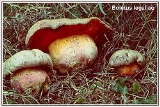
Boletus legaliae
Encyclopedia
Boletus legaliae, previously known as B. splendidus or B. satanoides, is a basidiomycete fungus
of the boletaceae
family. It is poisonous
, with predominantly gastrointestinal symptoms, and is related to Boletus satanas.
is initially off-white, or coffee-coloured at the button stage. In mid life it often (but not always) turns a pale mouse grey. In old age the cap turns reddish, or what has been described as 'old rose'. It may reach 14 cm (6 in) in diameter.
The stipe
is stocky, with a narrow red reticulation (net pattern) on an orange ground at the apex. This orange ground colour fades gradually towards the mid-section, making the red reticulation more pronounced. At the base the reticulation is absent, and the stem
turns dark vinaceous. Sometimes the stem detail can be faint, or even absent when covered with earth or leaf litter. The pores are initially red, but have an overall orange colour when mature, and they bruise blue. The flesh turns pale blue on cutting / dark vinaceous in the stem base. The flesh is said to smell of chicory
.
, which turns brownish-ochre, lacking the overall reddish tones in maturity. It has a more nauseating smell, and it is poisonous, possibly deadly.
, and Europe
.
Grows with oak (Quercus) and beech (Fagus
) often on neutral to acid soils.
Fungus
A fungus is a member of a large group of eukaryotic organisms that includes microorganisms such as yeasts and molds , as well as the more familiar mushrooms. These organisms are classified as a kingdom, Fungi, which is separate from plants, animals, and bacteria...
of the boletaceae
Boletaceae
Boletaceae are a family of mushrooms, primarily characterized by developing their spores in small pores on the underside of the mushroom, instead of gills, as are found in agarics. Nearly as widely distributed as agarics, they include the Cep or King Bolete , much sought after by mushroom hunters...
family. It is poisonous
Mushroom poisoning
Mushroom poisoning refers to harmful effects from ingestion of toxic substances present in a mushroom. These symptoms can vary from slight gastrointestinal discomfort to death. The toxins present are secondary metabolites produced in specific biochemical pathways in the fungal cells...
, with predominantly gastrointestinal symptoms, and is related to Boletus satanas.
Taxonomy
Boletus legaliae was described by Czech mycologist Albert Pilát in 1968. It is named after the French mycologist Marcelle Le Gal. Boletus splendidus as described by Charles-Édouard Martín in 1894 is a synonym. The description of Boletus satanoides was too vague to be ascribed to any actual species.Description
The capPileus (mycology)
The pileus is the technical name for the cap, or cap-like part, of a basidiocarp or ascocarp that supports a spore-bearing surface, the hymenium. The hymenium may consist of lamellae, tubes, or teeth, on the underside of the pileus...
is initially off-white, or coffee-coloured at the button stage. In mid life it often (but not always) turns a pale mouse grey. In old age the cap turns reddish, or what has been described as 'old rose'. It may reach 14 cm (6 in) in diameter.
The stipe
Stipe (mycology)
thumb|150px|right|Diagram of a [[basidiomycete]] stipe with an [[annulus |annulus]] and [[volva |volva]]In mycology a stipe refers to the stem or stalk-like feature supporting the cap of a mushroom. Like all tissues of the mushroom other than the hymenium, the stipe is composed of sterile hyphal...
is stocky, with a narrow red reticulation (net pattern) on an orange ground at the apex. This orange ground colour fades gradually towards the mid-section, making the red reticulation more pronounced. At the base the reticulation is absent, and the stem
Stipe (mycology)
thumb|150px|right|Diagram of a [[basidiomycete]] stipe with an [[annulus |annulus]] and [[volva |volva]]In mycology a stipe refers to the stem or stalk-like feature supporting the cap of a mushroom. Like all tissues of the mushroom other than the hymenium, the stipe is composed of sterile hyphal...
turns dark vinaceous. Sometimes the stem detail can be faint, or even absent when covered with earth or leaf litter. The pores are initially red, but have an overall orange colour when mature, and they bruise blue. The flesh turns pale blue on cutting / dark vinaceous in the stem base. The flesh is said to smell of chicory
Chicory
Common chicory, Cichorium intybus, is a somewhat woody, perennial herbaceous plant usually with bright blue flowers, rarely white or pink. Various varieties are cultivated for salad leaves, chicons , or for roots , which are baked, ground, and used as a coffee substitute and additive. It is also...
.
Similar species
Boletus satanas Lenz, which is found in broad-leaved woodland on calcareous soil, has a whiter capPileus (mycology)
The pileus is the technical name for the cap, or cap-like part, of a basidiocarp or ascocarp that supports a spore-bearing surface, the hymenium. The hymenium may consist of lamellae, tubes, or teeth, on the underside of the pileus...
, which turns brownish-ochre, lacking the overall reddish tones in maturity. It has a more nauseating smell, and it is poisonous, possibly deadly.
Distribution and habitat
Uncommon in Southern EnglandSouthern England
Southern England, the South and the South of England are imprecise terms used to refer to the southern counties of England bordering the English Midlands. It has a number of different interpretations of its geographic extents. The South is considered by many to be a cultural region with a distinct...
, and Europe
Europe
Europe is, by convention, one of the world's seven continents. Comprising the westernmost peninsula of Eurasia, Europe is generally 'divided' from Asia to its east by the watershed divides of the Ural and Caucasus Mountains, the Ural River, the Caspian and Black Seas, and the waterways connecting...
.
Grows with oak (Quercus) and beech (Fagus
Beech
Beech is a genus of ten species of deciduous trees in the family Fagaceae, native to temperate Europe, Asia and North America.-Habit:...
) often on neutral to acid soils.

